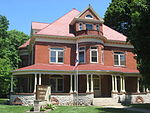Ross Correctional Institution
Ross Correctional Institution (RCI) is an Ohio Department of Rehabilitation and Correction (ODRC) close security state prison for men located in Ross County, Ohio, near Chillicothe, Ohio, adjacent to the medium-security Chillicothe Correctional Institution and the Hopewell Culture National Historical Park. First opened in 1987, Ross houses 2,037 inmates. The institution covers 1,707 acres and employed over 350 security staff. As of January 6, 2016, there are 2085 inmates at the institution. Around 56% of the inmate population are classified as African American, 43% classified as Caucasian, and 0.01% classified as other. As of 2016, ODRC estimates that the daily cost for each inmate is $51.77.
Excerpt from the Wikipedia article Ross Correctional Institution (License: CC BY-SA 3.0, Authors).Ross Correctional Institution
SR 104, Chillicothe
Geographical coordinates (GPS) Address Phone number Website Nearby Places Show on map
Geographical coordinates (GPS)
| Latitude | Longitude |
|---|---|
| N 39.36808 ° | E -83.00167 ° |
Address
Chillicothe Correctional Institution
SR 104 15802
45601 Chillicothe
Ohio, United States
Open on Google Maps










